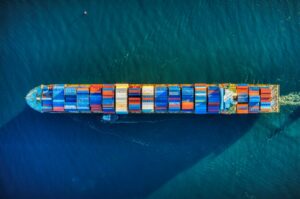As we enter the second half of 2023, the logistics industry faces a technological revolution. With Amazon recently patenting its ‘anticipatory shipping’ system that forecasts demand and moves goods ahead of customer orders, it is just a matter of time before logistics companies follow suit.
According to a 2021 McKinsey report, industry professionals that integrated AI into supply-chain management processes saw improved inventory levels by 35% and service levels by 65%. And one sub-area within the broader category of AI is making a noticeable impact: predictive analytics. By analyzing historical and external data, AI presents a holistic view of business operations. It identifies root causes and helps logistics companies discover historical patterns, trends, and seasonality that can be applied to foresee the future.
Where margins are tight, and competition is fierce, leveraging cutting-edge technology can help logistics companies remain competitive, reduce costs, and provide better customer service.
Let’s explore how data visibility and predictive analytics are set to shape the logistics landscape for the rest of 2023.
The Logistics Industry Swap From Manual to Digital
A 2022 study by Zencargo found 38% of supply chain professionals received outdated data, and 49% struggled with data accuracy. It didn’t help that over 20% of logistics providers relied on manual track-and-trace processes to locate their ocean freight, as cited in FourKites’ 2023 report. With data ageing quickly and the heavy use of manual entry, gaining data visibility across supply chains was extremely difficult.
Companies are switching to automated data capture to ensure continuous data flow and real-time decision-making. Logistics providers can automatically track goods and processes using data capture tools such as asset trackers, dispatch cameras with computer vision, and warehouse sensors.
On top of this, electronic data interchange (EDI) and application programming interfaces (APIs) help shipping companies connect their systems and electronically communicate information such as purchase orders, advance ship notices, and invoices, traditionally communicated on paper. With continuous data streams, logistics professionals can ensure systems are updated with accurate information and identify issues before they escalate further down the supply chain.
Successful Analytics With Data Harmonized Under One Roof
The technological landscape for logistics companies is vast—generating a lot of data. So, while consistently gathering quality data is part of the battle, reviewing all the data simultaneously is also increasingly difficult.
Many operate in complex technological landscapes with Transport Management Systems (TMS), financial systems, and telematics, not to mention third-party data sources and lots of information stored and maintained in Excel. Merging and mapping this data, alongside maintaining the underlying data quality, represents a major hurdle to visibility, productivity, and efficiency.
One solution is to organize the various data streams into a central system by building data lakes—centralized repositories that can store structured and unstructured data at any scale. This enables organizations to connect the data from different sources and create a single version of the truth.
Nevertheless, data inconsistencies across different formats can cause readability errors. Engineers and data scientists must prioritize eliminating inconsistencies within the data, connecting multiple sources, and transforming data formats for success. Good data management, such as regularly ensuring high-quality and relevant data, and adopting company-wide data standards, can support smooth data-sharing processes.
Predictive Analytics Help Logistics Professionals Make Effective Decisions
Logistics companies turn to predictive analytics to inform strategic data-driven decisions, particularly for efficient inventory management, resource, and capacity planning.
Suppose an ocean shipping company wants to cut costs. Yet, it always keeps big reserves to satisfy a non-existent demand, which is inefficient. With the help of predictive analytics and demand forecasting, container managers can begin to identify the optimal stock levels and asset type at any given time and place, resupplying only the right amount of containers at the time needed. This helps to be able to avoid unnecessary storage costs—especially in expensive locations. Best practices include keeping just enough buffers to satisfy the expected demand instead of large reserves that are never needed.
Defining the optimal stock levels should be dynamic as it is very prone to market conditions. For this reason, AI-powered demand forecasting can support turning market volatility from threat to opportunity.
Feeding the last few years of historical container booking and event data into AI-powered demand forecasting models, logistics professionals can draw insights to identify trends and create accurate predictions. And the more granular and high-quality the data, the better they can align supply and demand.
With reliable estimations, logistics providers can identify and cancel unnecessary trips or efficiently add trips by securing capacity in advance. That’s because while short to mid-term predictions of two days to 12 weeks highly influence operational planning, long-range forecasts are good for planning new asset purchases or expanding businesses into new geographies. Logistics professionals can use the data-driven insights to optimize their processes, and their cost savings can support investments in additional resources to scale.
Capturing data in a centralized manner not only helps logistics professionals make attuned business decisions to meet clients’ rising expectations, but it’s also a prerequisite for predictive analytics. Today’s logistics providers must continuously gather information, predict future demand, and analyze predictions against actual volumes to build resilient logistics and supply chains—and AI is helping manage the load.
Author Bio
Dimitar Pavlov, is the Chief Growth Officer at Transmetrics, a logistics technology provider specializing in container management automation and optimization. With extensive experience in the technology and logistics industries, Pavlov is responsible for overseeing revenue generation strategies and developing partnerships with key clients and partners. His leadership has been critical to Transmetrics’ success in offering innovative solutions that help logistics companies automate and optimize their container management processes for increased efficiency and profitability.
- SEO Powered Content & PR Distribution. Get Amplified Today.
- PlatoData.Network Vertical Generative Ai. Empower Yourself. Access Here.
- PlatoAiStream. Web3 Intelligence. Knowledge Amplified. Access Here.
- PlatoESG. Automotive / EVs, Carbon, CleanTech, Energy, Environment, Solar, Waste Management. Access Here.
- PlatoHealth. Biotech and Clinical Trials Intelligence. Access Here.
- ChartPrime. Elevate your Trading Game with ChartPrime. Access Here.
- BlockOffsets. Modernizing Environmental Offset Ownership. Access Here.
- Source: https://logisticsmatter.com/data-visibility-and-predictive-analytics-whats-in-store-for-logistics-companies-in-2023/
- :has
- :is
- :not
- 1
- 12
- 2021
- 2022
- 2023
- 35%
- 8
- a
- Able
- accuracy
- accurate
- across
- actual
- add
- Additional
- Adopting
- advance
- against
- ahead
- AI
- AI-powered
- align
- All
- alongside
- also
- always
- Amazon
- amount
- an
- analytics
- analyze
- analyzing
- and
- any
- APIs
- Application
- ARE
- AS
- asset
- At
- automate
- Automated
- automatically
- Automation
- avoid
- Battle
- BE
- because
- been
- before
- Better
- Big
- booking
- broader
- build
- Building
- business
- business operations
- businesses
- but
- by
- cameras
- CAN
- Capacity
- capture
- Category
- Cause
- causes
- central
- centralized
- chain
- chains
- chief
- cited
- clients
- communicate
- communicated
- Companies
- company
- competition
- competitive
- complex
- computer
- Computer Vision
- conditions
- Connect
- Connecting
- Container
- Containers
- continuous
- continuously
- Cost
- cost savings
- Costs
- create
- critical
- customer
- Customer Service
- Cut
- cut costs
- cutting-edge
- data
- data management
- data quality
- data-driven
- Days
- Decision Making
- decisions
- Demand
- Demand forecasting
- developing
- different
- difficult
- discover
- Dispatch
- down
- draw
- dynamic
- Effective
- efficiency
- efficient
- efficiently
- Electronic
- electronically
- eliminating
- enables
- Engineers
- enough
- ensure
- ensuring
- Enter
- entry
- Errors
- Event
- Excel
- expanding
- expectations
- expected
- expensive
- experience
- explore
- extensive
- Extensive Experience
- external
- extremely
- faces
- few
- fierce
- financial
- financial systems
- flow
- follow
- For
- forecasts
- foresee
- freight
- from
- further
- future
- gaining
- gather
- generation
- geographies
- given
- good
- goods
- Growth
- Half
- heavy
- help
- helping
- helps
- high-quality
- highly
- his
- historical
- holistic
- How
- HTTPS
- identifies
- identify
- Impact
- improved
- in
- include
- increased
- increasingly
- industries
- industry
- inefficient
- influence
- inform
- information
- innovative
- insights
- instead
- integrated
- interfaces
- into
- inventory
- Inventory Management
- Investments
- issues
- IT
- ITS
- jpg
- just
- keeping
- Key
- landscape
- large
- Last
- Leadership
- levels
- leveraging
- load
- locations
- logistics
- Lot
- maintaining
- major
- make
- Making
- manage
- management
- manner
- manual
- mapping
- margins
- Market
- market conditions
- market volatility
- Matter
- McKinsey
- Meet
- mention
- merging
- models
- more
- moves
- multiple
- must
- needed
- never
- New
- ocean
- of
- offering
- Officer
- on
- ONE
- only
- operate
- operational
- Operations
- Opportunity
- optimal
- optimization
- Optimize
- or
- orders
- organizations
- overseeing
- Paper
- part
- particularly
- partners
- partnerships
- patterns
- Place
- planning
- plato
- Plato Data Intelligence
- PlatoData
- predict
- Predictions
- Predictive Analytics
- presents
- Prioritize
- processes
- productivity
- professionals
- profitability
- Programming
- provide
- provider
- providers
- purchase
- purchases
- quality
- quickly
- real-time
- reason
- received
- recently
- reduce
- regularly
- relevant
- reliable
- remain
- report
- represents
- reserves
- resilient
- resource
- Resources
- responsible
- REST
- revenue
- reviewing
- Revolution
- right
- rising
- root
- Savings
- saw
- Scale
- scientists
- Second
- securing
- sensors
- service
- set
- Shape
- Shipping
- Short
- should
- simultaneously
- single
- smooth
- So
- solution
- Solutions
- Sources
- specializing
- standards
- stock
- storage
- store
- stored
- Strategic
- strategies
- streams
- structured
- structured and unstructured data
- Study
- success
- such
- Suit
- supply
- Supply and Demand
- supply chain
- Supply chains
- support
- swap
- system
- Systems
- technological
- Technology
- telematics
- that
- The
- The Future
- their
- they
- third-party
- third-party data
- this
- threat
- time
- to
- today’s
- tools
- top
- track
- Trackers
- traditionally
- transforming
- transport
- Transport Management Systems
- Trends
- truth
- TURN
- Turning
- two
- under
- underlying
- updated
- use
- using
- various
- version
- very
- View
- visibility
- vision
- Volatility
- wants
- Warehouse
- was
- we
- webp
- Weeks
- which
- while
- with
- within
- years
- yet
- zephyrnet













